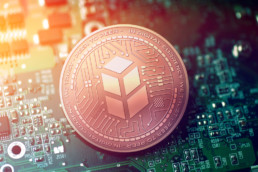Bancor Trade Recommendation
Author: Kiril Nikolaev / Source: Hacked: Hacking Finance

The Bancor/Bitcoin (BNT/BTC) pair dropped to as low as 0.00017359 on September 12, 2018. At that price, the market lost over 84% of its value from this year’s high of 0.00110062.
It looked as if the pair had more room to plummet. This is because bears managed to breach historic support of 0.000185. However, bulls held their ground and lifted BNT/BTC above the support. This created a bear trap and gave the market the strength to carve a bottom. More importantly, it provided bulls the fuel to kickstart a bull run.
Technical analysis shows that BNT/BTC is positioning to take out resistance of 0.000227. Breach of this resistance would trigger the breakout from the symmetrical triangle pattern on the 4-hour chart.
On top of that, we can...
JPMorgan’s focus on blockchain is part of their digital transformation roadmap
Author: Marie Huillet / Source: Cointelegraph

A study into JPMorgan’s digital transformation initiatives has revealed that blockchain is a key technology for the bank’s roadmap, according to a press release published by ResearchAndMarkets.com (RM) October 3.
RM has analyzed JPMorgan’s enterprise-wide strategies to secure its “competitive edge” against rival banks, non-financial firms, and fintech startups. The bank has reportedly earmarked $10.8 billion for technology spending in 2018, $5 billion of which will go towards fintech investments.
The study covers JPMorgan’s digital transformation roadmap, with blockchain listed as the first in a range of bleeding-edge technologies that are being pursued by the bank — including big data, cloud, artificial intelligence (AI), and robotics.
It...
IOTW's ICO Analysis and 15 billion IoT devices in the world
Author: Joshua Larson / Source: Hacked: Hacking Finance

There are already over 15 billion IoT devices in the world. These devices carry lots of data usage statistics that could be very valuable to the right companies. The problem until recently is that it’s almost impossible to collect all of this valuable data in an organized way. But now the experienced team at IOTW has invented a way to easily connect any IoT device to their blockchain. Once connected, the IoT device becomes a node and mines IOTW tokens as a reward to the device users. The usage data is then collected and sold to companies in exchange for IOTW tokens.
Based in Hong Kong, IOTW is a product of the groundbreaking Blockchain company, AnApp Blockchain Technologies Ltd. The IOTW blockchain software will operate an open-SDK, allowing any device to load the blockchain app and gain access to the IOTW blockchain ecosystem.
In order to incentivize users to connect their IoT devices/appliances to their blockchain, the hard working team has developed 2 unique new protocols; “Micro Mining” and “Proof of Assignment.” Together, these protocols allow every household to join the mining community without restrictions. Each device they connect will become a node, and each node will have the same chance of being selected to mine as all the other nodes in the network. No whale power on this chain.
How it works:
- Download their software through firmware upgrades to connect any device to the IOTW Ecosystem.
- Start mining with very little power consumption.
- Redeem rewards. “IoT device owners will be rewarded with IOTW coins which the devices can use to call up services or spare parts. The owners can also use the IOTW coins to buy goods, services and media content in open markets.”
- Sell your data for more IOTW tokens. “IOTW blockchain will collect big data. Allowing global, city-wide, and district-wide energy saving optimization.”
Here’s a 7-minute video we were linked to by their Telegram mod. It does a great jump of explaining why IOTW is such an exciting project. The video has already received an impressive 56,000 views, and is worth checking out.
In addition, IOTW plans to allow for the development of decentralized applications on IoT devices. And they will establish a decentralized purchase network for IOTW holders to bypass the middlemen and purchase directly from device makers and service providers.
Also, the team invented a Digital Power System chipset (“DPS chipset”) that replaces traditional analog power systems in small appliances with digital power systems. From the company:
“We believe the DPS chipset will be able to see adoption by a certain number of device manufacturers for saving costs while increasing device functionality. We have already filed a patent for the DPS chipset design. We plan to file a few more patents for this new product.”
Token
IOTW will have the following utility:
- Device users receive IOTW token as rewards for mining, as well as for selling their usage data.
- Device makers, research institutes, government agencies, and other organizations can purchase usage data with IOTW.
- Goods and services providers will sell through the online mall accepting IOTW as a payment method.
- A percentage of IOTW will be taken as a processing fee for each transaction.
The Proof of Assignment protocol requires way less power for mining than Proof of Work....
The Privacycoins Battles and Why Dash Is Not Really That Private
Author: Aaron van Wirdum / Source: Bitcoin Magazine

Based on blockchain technology, most cryptocurrencies have an open and public ledger. While this is required for these systems to work, it comes with a significant downside: Privacy is often quite limited. Government agencies, analytics companies and other interested parties — let’s call them “spies” — have ways to analyze the public blockchains and peer-to-peer networks of cryptocurrencies like Bitcoin, to cluster addresses and tie them to IP addresses or other identifying information.
Unsatisfied with Bitcoin’s privacy features, several cryptocurrency projects have, over the years, launched with the specific goal to improve on them. And not without success. Several of these privacycoins are among the most popular cryptocurrencies on the market today.
However, as detailed in this month’s cover story, Bitcoin’s privacy features have recently seen significant improvements as well and are set to further improve over the next months and years. This miniseries will compare different privacycoins to the privacy offered by Bitcoin.
In part one: Dash.
Background
Dash (DASH) is among the most popular but also the more controversial cryptocurrencies in the space today.
Originally a codebase fork from Litecoin (which is in turn a codebase fork of Bitcoin), Dash was launched by its founder Evan Duffield in January 2014 as Xcoin. The project was quickly rebranded to Darkcoin, seemingly in reference to Dark Wallet, a now-defunct, privacy-focused bitcoin wallet project. Darkcoin rebranded a second time in early 2015, to the current name Dash, which stands for "digital cash.” At the time of writing, Dash claims a 12th spot on the cryptocurrency market cap lists, down from a top five spot for some time in early 2017.
Much of the controversy surrounding Dash stems from the early days of the project. While the coin was not premined, it was instamined. As the cryptocurrency went live, miners created 2 million coins in a matter of days. Quite a significant amount, with a projected supply currently scheduled for a total of 22 million, and some 8 million coins in circulation today. According to Duffield, himself one of the early miners, the instamine was an accident. But instead of fixing the problem — for example, by changing the protocol rules or relaunching — it was decided that the coin would continue despite the instamine.
Since then, Dash has turned into (what it calls) a decentralized autonomous organization, or DAO, and prides itself on being the first successful example of such an organization. The DAO centers around Dash “masternodes” — DASH nodes that stake (proof of ownership) at least 1000 DASH — and should help the network in certain ways, for instance by confirming “instant transactions.” In return, these masternodes receive 45 percent of newly generated DASH.
Another 10 percent of every block reward is reserved for the Dash treasury. What happens with these funds is decided by the masternodes by vote. In practice, this money funds the Dash Core Group, effectively the company behind Dash, today headed...
eCommerce Startup Ticket Monster (TMON) Raises $32 Million to Create Crypto Stablecoin
Source: Cointelegraph

South Korea ecommerce marketplace Ticket Monster (TMON) revealed it had closed a $32 million funding round for its new stablecoin.
TMON, which boasts a considerable $4 billion in total sales, is seeking to create an in-house cryptocurrency to compliment its existing token, Luna, which acts as collateral on its blockchain platform.
Contributing to the round are some of the cryptocurrency industry’s best-known names, including Binance Labs, OKEx and Huobi Capital, as well as funds including Polychain Capital.
“From experience, I know that faster, more secure transactions...
Being a Woman Entrepreneur In China's Get-Rich-Quick Crypto Culture
Sa Wang has co-founded several successful companies in the tech and blockchain space, first at popular Chinese self-service kiosk startup Dora, and now at top 50 crypto project and blockchain protocol IOST.
Source: CoinDesk
We hear a lot about women (or the lack thereof) in the cryptocurrency and blockchain space.
Confirming what many of us already suspected, CoinDesk's Q2 2018 State of the Blockchain Report found that only 4 percent of crypto investors are women. In tandem, reporters regularly call the "blockchain bros" on the carpet for elbowing women out of yet another lucrative emerging industry.
But this has been a predominantly West-centric conversation, casting the spotlight on gender inequality and underrepresentation at Western crypto companies, Western blockchain conferences, and Western meetups.
Thus far, news articles, Twitter threads, and Medium posts have largely neglected the diversity of female experiences in other parts of the world, such as China, South Korea and Japan, where the crypto space is equally — if not more — dynamic and growing.
Take China, for instance. Despite banning ICOs and bringing bitcoin trading to a virtual standstill, in 2017, China was responsible for over half of the world's blockchain-related patent applications — with the U.S. coming in a distant second. The top three cryptocurrencies by market cap launched in 2018 — Zilliqa, Ontology, and IOST — are all Chinese.
With such a strong Asian presence in the blockchain world, why do we rarely hear about Asian women in crypto? What can the rest of the world learn from our experiences?
Chinese women in crypto
In order to understand what it's like to be a Chinese woman in crypto, first you must understand the Chinese crypto space itself.
Despite China's ban on crypto trading, there is a ravenous appetite for crypto wealth — traders have simply started placing their bets in Japan, Hong Kong, and South Korea. The regulatory crackdowns have done little to stifle the hundreds of scam crypto projects in China (many of them deployed overseas), while newly minted bitcoin millionaires — mostly male with no education or merits necessary — abound.
In contrast to the West, where conversations are slowly evolving towards a more nuanced discussion of the merits of blockchain technology and institutional adoption, Chinese crypto enthusiasts largely maintain a single-minded speculative focus: Will this coin be listed on a Korean exchange soon? What is its market cap? Should I buy? Should I sell?
This get-rich-quick mentality makes it very difficult for serious blockchain advocates — especially females, who already have to fight for a voice — to cut through the noise and evangelize a longer-term (and much less sexy) message.
As Carylyne Chan of CoinMarketCap writes in her fascinating and detailed account of Chinese crypto culture:
"Scam cases… have engendered many tragedies, and created a more insidious impact: For those who truly believe in the blockchain, such scams are smearing the blockchain technology...
Ethereum Founder Vitalik Buterin Just Might Have a Solution for the Crypto Funding Problem
Author: Vitalik Buterin / Source: CoinDesk
There are free-riders in the cryptocurrency ecosystem.
At least, that's the contention of a new paper, shared with CoinDesk on Monday, written by ethereum founder Vitalik Buterin, Microsoft researcher Glen Weyl and Ph.D. of economics at Harvard, Zoë Hitzig.
And free-riders pose a problem.
Described in the paper, free-riders are people or businesses that profit from the under-provision of public goods. And, on top of that, "the more people [these public goods] benefit the more they will be under-provided." It's an issue that plagues development even outside the cryptocurrency space, but the authors are – at least – initially focused on how the idea creates harmful incentives for the funding of blockchain projects.
Whereas currently, crypto development teams rely largely on donations, the altruistic whims of their creators, and ICOs — the paper details a new financing method to support a "self-organizing ecosystem of public goods."
Titled "Liberal Radicalism: Formal Rules for a Society Neutral among Communities," the method described – a system written in code – seeks to allow groups to allocate funds for the maintenance of public goods and services without becoming vulnerable to the "free-rider" problem.
The mechanism is similar in principle to Quadratic Voting, a form of stake-based voting championed by Weyl in a recent booked, "Radical Markets."
While Quadratic Voting allows participants to vote with crypto tokens according to how much they care about an issue, Liberal Radicalism (LR) expands the same concept to how communities contribute to public goods, such as software development, cryptocurrencies and journalism.
And it works by increasing the funding of projects incrementally depending on the number of participants and the degree to which they care about the issue at hand.
"Individuals make public goods' contributions to projects of value to them. The amount received by the project is (proportional to) the square of the sum of the square roots of contributions received," the paper states.
And while the authors have ambitions for the technology that are far-reaching (including applying the code to municipal projects and campaign financing) cryptocurrency communities, with their open-minded attitudes towards experimentation, are a "particularly appropriate" testing ground for the technology.
Speaking to CoinDesk, co-author of the paper Hitzig said that interest is already building between many different groups. That currently includes about "a half dozen" cryptocurrency communities looking to potentially implement the technology, as well as "other innovators and philanthropists."
As such, Hitzig told CoinDesk:
"Once we circulate the paper we expect that experimentation will begin in earnest shortly thereafter."
The crisis of liberalism
The new paper is part of an ongoing collaboration between Buterin and Weyl since the publication of the latter's "Radical Markets" book.
As detailed by CoinDesk, the duo co-authored a blog post in May, in which the authors discussed their shared interest to "harness markets and technology to radically decentralize power of all sorts and shift our reliance from authority and to...
Australian Securities Exchange Delays Their Switch to Blockchain
Author: Marie Huillet / Source: Cointelegraph

The Australian Securities Exchange (ASX) has announced that it will delay its transition to use blockchain for equity transactions by six months, the Sydney Morning Herald reports September 4.
As Cointelegraph has previously reported, the ASX has been working to implement blockchain as of December 2017 to replace its current system for processing equity transactions.
According to the Sydney Morning Herald, the decision to delay the move comes as the exchange plans to devote more time to user development and testing. The launch date for the switchover has now been moved from the fourth quarter of 2020 to March-April...
Rateonium Blockchain CRM: ICO
Source: Upcoming ICOs and Crowdsales, Ratings and Reviews of Top ICOs
Idea:
Elevator pitch Rateonium is using blockchain technology to create new horizons for the management of customer-company relationships. The platform connects products and services purchased with a subsequent customer review process.
Problem: Customer reviews of products and services are responsible for the long-term success of a company. New leads rely on customer opinions, not on corporate communication.
•75% of consumers only make a purchase decision after reading the reviews
•40% of consumers distrust offers with no customer ratings
•20% of consumers believe that most ratings are falsified
•2% of customers write reviews Too few customers write...
South Korea to Double Public Sector Blockchain Trials Next Year
Source: CoinDesk
The South Korean government is literally doubling down on its efforts to trial blockchain in the public sector, adding more projects and increasing available funds for 2019.
The Korea Internet & Security Agency (KISA) – a sub-organization of the Ministry of ICT – has said it is aiming to increase the number of blockchain pilot projects in the public sector from six this year to 12 in 2019, as CoinDesk Korea reported on Tuesday.
"In the next year, we are considering expanding blockchain pilot projects in the public sector to 12, and plan to support more than three private-led blockchain national projects," said Min Kyung-sik, head of KISA's blockchain team.
Further, the government agency will also boost the blockchain pilot budget for 2019 to more than 10 billion Korean won,...











